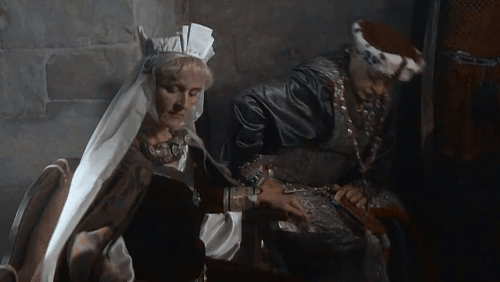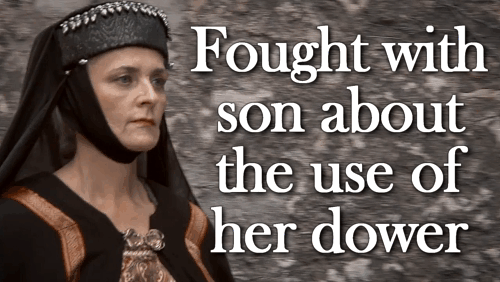#ringelheim
Text
Today in Christian History

Today is Tuesday, March 14th, the 73rd day of 2023. There are 292 days left in the year.
Today’s Highlight in History:
968: Death of Matilda of Ringelheim, German queen, and mother of Emperor Otto I. Because she had been charitable and founded monasteries and churches, she will be regarded as a saint by the Roman Catholic Church.
1528: Basel passes a law that all Taufer (Anabaptists, etc) not forsaking their errors be fined £5 and those giving them aid likewise.
1661: William Leddra of Barbadoes becomes the last Quaker executed for his faith in Boston.
1858: Death of John Mason Peck at Rock Spring, Kentucky, having worn himself out as a frontier circuit rider and Baptist educator.
1930: Constantine Asklipiodovich Khlynov, serving as an Orthodox priest in Novorozhdestvenka, Bolsherechensky region, Siberia, is arrested by Communists. He will be accused of anti-Soviet and counter-revolutionary propaganda and agitation, and sentenced to death—a sentence that will be carried out in Omsk on June 8, 1930.
#Today in Christian History#March 14#William Leddra executed#Death of Matilda of Ringelheim#Death of John Mason Peck#Constantine Asklipiodovich Khlynov arrested by communists
5 notes
·
View notes
Text
The Cares of Euthostila Ringelheim
• [x] are not constant in number
• [x] keep things going
• [x] bubble up in the night
• [x] do not overwhelm
• [x] become muted with some alcohol and time spent with good friends
2 notes
·
View notes
Text
Wanna learn about women history and WWII? Here is a non-exhaustive list to get you started
German women and the Nazi regime
Mothers in the Fatherland: Women, the Family and Nazi Politics, Claudia Koonz
Female SS Guards and Workaday Violence: The Majdanek Concentration Camp, 1942-1944, Elissa Mailänder
Zwangssterilisation im Nationalsozialismus: Studien zur Rassenpolitik und Frauenpolitik, Gisela Bock
Hitler's Furies: German Women in the Nazi Killing Fields, Wendy Lower
"Backlash against Prostitutes' Rights: Origins and Dynamics of Nazi Prostitution Policies," in Journal of the History of Sexuality Julia Roos
"German Women and the Holocaust in the Nazi East," Wendy Lower, in Women and Genocide, Elissa Bemporad & Joyce W. Warren
Frausein im Dritten Reich, Rita Thalmann
Women as victims or perpetrators of the Holocaust (general)
"Women and the Holocaust: A Reconsideration of Research," in Signs, Joan Ringelheim
Women in the Holocaust, Dalia Ofer & Lenore J. Weitzman
Das KZ-Bordell: Sexuelle Zwangsarbeit in nationalsozialistischen Konzentrationslagern, Robert Sommer
SS-Bordelle und Oral History. Problematische Quellen und die Existenz von Bordellen für die SS in Konzentrationslagern, Christa Paul & Robert Sommer
Sexual Violence during the Holocaust—The Case of Forced Prostitution in the Warsaw Ghetto, in Shofar: An Interdisciplinary Journal of Jewish Studies, Katarzyna Person
"Gender: A Crucial Tool in Holocaust Research," Marion Kaplan, in Women and Genocide, Elissa Bemporad & Joyce W. Warren
Different Voices: Women and the Holocaust, Carol Rittner & John K. Roth
Resilience and Courage: Women, Men, and the Holocaust, Nechema Tec
« Reframing Sexual Violence as a Weapon and Strategy of War: The Case of the German Wehrmacht during the War and Genocide in the Soviet Union, 1941–1944 », in Journal of the History of Sexuality, Regina Mühlhäuser
Sex and the Nazi soldier. Violent, commercial and consensual encounters during the war in the Soviet Union, 1941-45, Regina Mülhäuser
Romani women during the Holocaust
« Krieg im Frieden im Krieg: Reading the Romani Holocaust in terms of race, gender and colonialism », Eve Rosenhaft
« Hidden Lives : Sinti and Roma Women », Sybil Milton
« Romani women and the Holocaust Testimonies of Sexual Violence in Transnistria », Michelle Kelso
"No Shelter to Cry In: Romani Girls and Responsibility during the Holocaust," Michelle Kelso, in Women and Genocide, Elissa Bemporad & Joyce W. Warren
Jewish women during the Holocaust
Jewish women's sexual behaviour and sexualized abuse during the Nazi era, in The Canadian Journal of Human Sexuality, Beverley Chalmers
Sexual Violence against Jewish Women During the Holocaust, Sonja M. Hedgepeth & Rochelle G. Saidel
Persecution of lesbians by the Nazis
Days of Masquerade: Life Stories of Lesbians during the Third Reich, Claudia Schoppmann
Nationalsozialistische Sexualpolitik und weibliche Homosexualität, Claudia Schoppmann
“This Kind of Love”: Descriptions of Lesbian Behaviour in Nazi Concentration Camps, from Nationalsozialistische Sexualpolitik und weibliche Homosexualität, Claudia Schoppmann
Queer in Europe during the Second World War, Regis Schlagdenhauffen
Ravensbrück
Ravensbrück. Everyday Life in a Woman’s Concentration Camp 1939-45, Jack G. Morrison
Ravensbruck: Life and Death in Hitler's Concentration Camp for Women, Sarah Helm
Women and the Memory of WWII
Women, Genocide, and Memory: The Ethics of Feminist Ethnography in Holocaust Research, in Gender & Society, Janet Jacobs
Lessons Learned from Gentle Heroism: Women's Holocaust Narratives, in The Annals of the American Academy of Political and Social Science, Myrna Goldenberg
« An Austrian Roma Family Remembers: Trauma and Gender in Autobiographies by Ceija, Karl, and Mongo Stojka », Lorely French
Beyond Survival: Navigating Women's Personal Narratives of Sexual Violence in the Holocaust, Roy Schwartzman
Comfort Women and imperial Japan
Comfort Women: Sexual Slavery in the Japanese Military During World War II, Yoshimi Yoshiaki
The Comfort Women: Japan’s Brutal Regime of Enforced Prostitution in the Second World War, George Hicks
The Japanese Comfort Women and Sexual Slavery During the China and Pacific Wars, Caroline Norma
Lola's House: Filipino Women Living With War, Evelina Galang
Soviet Women during WWII
« “Girls” and “Women”. Love, Sex, Duty and Sexual Harassment in the Ranks of the Red Army 1941-1945 », in The Journal of Power Institutions in Post-Soviet Societies, Brandon M. Schechter
Soviet Women on the Frontline in the Second World War, Roger D. Markwick & Euridice Charon Cardona
Soviet Women in Combat. A History of Violence on the Eastern Front, Anna Krylova
#^ i know way more about the holocaust and women than other topics and that's why there are barely any books on women soldiers (except for#german women soldiers - duh - and soviet women (that's bc they were assigned readings))#and i included stuff in german because those books haven't been translated in english but i still think my german speaking mutuals would be#interested in them#holocaust#wwii#herstory
86 notes
·
View notes
Note
Hello!! I've come here with a humble request. I'm currently writing a thesis on how the situation of Jewish women and men differed during Holocaust and I've found your speech: 'Girls with Guns, Woman Commanders, and Unheeded Warnings: Women and the Holocaust' to be an amazing starting point. Could you direct me to the sources you used when preparing it? (sincere apologies if this has been answered before, and thank you!!) Have a great day ✿✿✿
First of all, thank you SO MUCH for your kind words about that piece. For anyone who doesn't know which piece we're referring to, it's this one.
So just so we're all on the same page, I'm going to approach this question like you're an upper level undergrad History major and I'm the graduate teaching assistant in charge of guiding you through this research planning process. So, before I start to give you names and titles, I'm going to pose some questions for you to consider: which European Jews are you writing about? Eastern European? Western European? Southern European? Ashkenazic? Sephardic? Polish? Greek? Dutch? Religious? Hasidic? Secular? Factory-owning class? Working class? Because gendered experiences of and responses to the Holocaust will also be shaped by nationality, religiosity, class, and region.
When you've chosen your region/niche/group, I'd recommend starting at least 100 years before the Holocaust. Like, when I was writing about German Jewish female refugees in Shanghai for my MA thesis, to understand their behavior and responses, I had to start in the 1800s to get a better idea of the historical experience, trajectory, and socialization of German Jewish women.
The post you're referring to was more about memory and its silences than it was about a specific group, so the sources for that are extremely general. Since you're still determining your scope, I'm going to give you some names of historians whose bibliographies you should explore yesterday:
-Marion Kaplan
-Paula Hyman
-Dalia Ofer
-Zoe Waxman
-Joan Ringelheim
-Carol Rittner
-Lenore Weitzman
And some titles to help you grasp the basics, presented in no particular order:
Between Dignity and Despair: Jewish Life in Nazi Germany by Marion Kaplan
Writing the Holocaust: Identity, Testimony, Representation by Zoe Waxman
Different Voices: Women and the Holocaust edited by Carol Rittner
Women in the Holocaust edited by Dalia Ofer and Lenore J. Weitzman
Gender and Jewish History edited by Marion Kaplan and Deborah Dash Moore
Sexual Violence Against Jewish Women During the Holocaust edited by Sonja M. Hedgepeth and Rochelle G. Saidel [this one is rough; only use it if you are 800% sure this is the lens you want to use]
Gender and Assimilation in Modern Jewish History: The Roles and Representation of Women by Paula E. Hyman [no relation, though she is my grand-adviser]
Women in the Holocaust: A Feminist History by Zoe Waxman
I have a pretty good working knowledge of Modern Jewish European historiography, with a focus on gender, ~1700-Holocaust, so once you've narrowed your scope, let me know if I can provide additional titles/help/whatever.
#history#historiography#holocaust history#holocaust historiography#modern jewish history#jewish women#jewish historiography#resources
82 notes
·
View notes
Text
Partial List of Royal Saints
Saint Abgar (died c. AD 50) - King of Edessa, first known Christian monarch
Saint Adelaide of Italy (931 - 999) - Holy Roman Empress as wife of Otto the Great
Saint Ælfgifu of Shaftesbury (died 944) - Queen of the English as wife of King Edmund I
Saint Æthelberht of Kent (c. 550 - 616) - King of Kent
Saint Æthelberht of East Anglia (died 794) - King of East Anglia
Saint Agnes of Bohemia (1211 - 1282) - Bohemian Princess, descendant of Saint Ludmila and Saint Wenceslaus, first cousin of Saint Elizabeth of Hungary
Saint Bertha of Kent (c. 565 - c. 601) - Frankish Princess and Queen of Kent as wife of Saint Æthelberht
Saint Canute (c. 1042 - 1086) - King of Denmark
Saint Canute Lavard (1096 - 1131) - Danish Prince
Saint Casimir Jagiellon (1458 - 1484) - Polish Prince
Saint Cormac (died 908) - King of Munster
Saint Clotilde (c. 474 - 545) - Queen of the Franks as wife of Clovis I
Saint Cunigunde of Luxembourg (c. 975 - 1033) - Holy Roman Empress as wife of Saint Henry II
Saint Edmund the Martyr (died 869) - King of East Anglia
Saint Edward the Confessor (c. 1003 - 1066) - King of England
Saint Edward the Martyr (c. 962 - 978) - King of the English
Saint Elesbaan (Kaleb of Axum) (6th century) - King of Axum
Saint Elizabeth of Hungary (1207 - 1231) - Princess of Hungary and Landgravine of Thuringia
Saint Elizabeth of Portugal (1271 - 1336) - Princess of Aragon and Queen Consort of Portugal
Saint Emeric (c. 1007 - 1031) - Prince of Hungary and son of Saint Stephen of Hungary
Saint Eric IX (died 1160) - King of Sweden
Saint Ferdinand (c. 1199 - 1252) - King of Castile and Toledo
Blessed Gisela of Hungary (c. 985 - 1065) - Queen Consort of Hungary as wife of Saint Stephen of Hungary
Saint Helena (c. 246 - c. 330) - Roman Empress and mother of Constantine the Great
Saint Henry II (973 - 1024) - Holy Roman Emperor
Saint Isabelle of France (1224 - 1270) - Princess of France and younger sister of Saint Louis IX
Saint Jadwiga (Hedwig) (c. 1373 - 1399) - Queen of Poland
Saint Joan of Valois (1464 - 1505) - French Princess and briefly Queen Consort as wife of Louis XII
Blessed Joanna of Portugal (1452 - 1490) - Portuguese princess who served as temporary regent for her father King Alfonso V
Blessed Karl of Austria (1887 - 1922) - Emperor of Austria, King of Hungary, King of Croatia, and King of Bohemia
Saint Kinga of Poland (1224 - 1292) - Hungarian Princess, wife of Bolesław V of Poland and niece of Saint Elizabeth of Hungary
Saint Ladislaus (c. 1040 - 1095) - King of Hungary and King of Croatia
Saint Louis IX (1214 - 1270) - King of France
Saint Ludmila (c. 860 - 921) - Czech Princess and grandmother of Saint Wenceslaus, Duke of Bohemia
Blessed Mafalda of Portugal (c. 1195 - 1256) - Portuguese Princess and Queen Consort of Castile, sister of Blessed Theresa of Portugal
Saint Margaret of Hungary (1242 - 1270) - Hungarian Princess, younger sister of Saint Kinga of Poland and niece of Saint Elizabeth of Hungary
Saint Margaret of Scotland (c. 1045 - 1093) - English Princess and Queen Consort of Scotland
Blessed Maria Cristina of Savoy (1812 - 1836) - Sardinian Princess and Queen Consort of the Two Sicilies
Saint Matilda of Ringelheim (c. 892 - 968) - Saxon noblewoman and Queen of East Francia as wife of Henry I
Saint Olaf (c. 995 - 1030) - King of Norway
Saint Olga of Kiev (c. 900 - 969) - Grand Princess of Kiev and regent for her son Sviatoslav I, grandmother of Saint Vladimir the Great
Saint Oswald (c. 604 - 642) - King of Northumbria
Saint Radegund (c. 520 - 587) - Thuringian Princess and Frankish Queen
Saint Sigismund of Burgundy (died 524) - King of the Burgundians
Saint Stephen of Hungary (c. 975 - 1038) - King of Hungary
Blessed Theresa of Portugal (1176 - 1250) - Portuguese Princess and Queen of León as wife of King Alfonso IX, sister of Blessed Mafalda
Saint Vladimir the Great (c. 958 - 1015) - Grand Prince of Kiev and grandson of Saint Olga of Kiev
26 notes
·
View notes
Text
SAINT OF THE DAY (March 14)

Matilda (also known as Matilda of Ringelheim), Queen of Germany and wife of King Henry I, was the daughter of Count Dietrich of Westphalia and Reinhild of Denmark.
She was born around 895 and was raised by her grandmother, the Abbess of Eufurt convent.
Matilda married Henry the Fowler, son of Duke Otto of Saxony, in the year 909.
He succeeded his father as Duke in the year 912. In 919, he succeeded King Conrad I to the German throne.
She was widowed in the year 936 and supported her son Henry's claim to his father's throne.
When her son Otto (the Great) was elected, she persuaded him to name Henry as Duke of Bavaria after he led an unsuccessful revolt.
St. Matilda was known for her considerable almsgiving. She was severely criticized by both Otto and Henry for what they considered as her extravagant gifts to charities.
As a result, she resigned her inheritance to her sons and retired to her country home.
She was later recalled to the court through the intercession of Otto's wife, Edith.
Matilda was welcomed back to the palace and her sons asked for her forgiveness.
In her final years, she devoted herself to the building of many churches, convents and monasteries.
She spent most of the declining years of her life at the convent she had built in Nordhausen.
She died at the monastery at Quedlinburg on 14 March 968 and was buried there with her late husband, Henry.
Matilda's two hagiographical biographies and The Deeds of the Saxons serve as authoritative sources about her life and work.
5 notes
·
View notes
Text
Holidays 3.14
Holidays
Bird Sanctuary Day
Celebrate Scientists Day
Crowdfunding Day
Daisy Day (French Republic)
Day of Solidarity (Lebanon)
The Day That Krabs Fries (SpongeBob Squarepants)
Dietician’s Day (Canada)
Dita e Veres (Summer Day; Albania)
Dog Theft Awareness Day (UK)
Dribble to Work Day
Emakeelepäev (Estonian Native language Day; Estonia)
Equal Pay Day 2023 ( website )
Genius Day
Gold Record Day
Gyalpyo (a.k.a. Gyallo Loshar (Nepal)
Heroes Day (Saint Vincent and Grenadines)
Immortal Barzani Day (Iraq)
International Ask A Question Day
International Day of Action for Rivers
International Day of Mathematics
International Social Prescribing Day
Learn About Butterflies Day
Legal Assistance Day
Legal Assistants Day
Logistics Innovation Day
Medicine Day (Turkey)
Moth-Er Day
Mother Tongue Day (Estonia)
My Freedom Day
Nanakshahi New Year (Sikhism)
National Botox Cosmetic Day
National Children's Craft Day
National Dog Theft Awareness Day (UK)
National Heroes Day (Saint Vincent and Grenadines)
National Landscape Day (Italy)
National Valerie Day
National Write Your Story Day
Native Language Day (Estonia)
Orthodox Book Day (Russia)
Pi Day
Professional Speakers Celebration Day
Save a Spider Day
Science Education Day
Steak and BJ Day [ website ]
Ten Most Wanted Day
314 Day
University Mental Health Day (UK)
Vinterfestuka begins (Narvik Sun Pageant; Norway)
Volunteer Day (Ukraine)
White Day (China, Japan, Korea)
World Book Day
World Day of Endometriosis
World Imagination Day
World Sikh Environment Day
Zeppelin Day
Food & Drink Celebrations
Bake a Pie Day (a.k.a. Bake a Pie in Solidarity Day)
National Potato Chip Day
National Reuben Sandwich Day
2nd Thursday in March
International School Meals Day [2nd Thursday]
Popcorn Lovers Day [2nd Thursday]
Railroad Day [2nd Thursday]
World Kidney Day [2nd Thursday]
Weekly Holidays beginning March 14 (2nd Week)
National Money Collectors Week [thru 3.16]
Independence & Related Days
Aebmark (Declared; 2016) [unrecognized]
Constitution Day (Andorra)
Kingdom of Wellmoore (Declared; 2020) [unrecognized]
New Year’s Days
Ghanian New Year’s celebration begins [thru 3.26]
Festivals Beginning March 14, 2024
AKC National Agility Championship [thru 3.17]
Florida Winefest (Sarasota, Florida) [thru 3.16]
Frozen Dead Guy Days (Nederland, Colorado) [thru 3.17]
Iowa Rabbit Festival (Iowa, Louisiana) [thru 3.16]
llano River Chuck Wagon Cook-Off (Llano, Texas) [thru 3.16]
Minsk International Book Fair (Minsk, Belarus) [thru 3.17]
Oakland restaurant Week (Oakland, California) [thru 3.24]
Rolling Loud California (Inglewood, California) [thru 3.17]
Vilnius International Film Festival or Kino Pavasaris (Vilnius, Lithuania) [thru 3.27]
Feast Days
Acepsimas, Bishop of Assyria (Christian; Saint)
Adolph Gottlieb (Artology)
Archimedes Day (Church of the SubGenius; Saint)
Boniface, Bishop of Ross, in Scotland (Christian; Saint)
Charlene the Chicken (Muppetism)
Day of Ua Kit (Ancient Egypt Serpent Goddess; Everyday Wicca)
The Diasia (Festival to Ward Off Poverty; Ancient Greece)
Equirria (Ancient Roman Chariot and Horse Race; 2nd of 2 / 1st one Feb. 27)
Eutychius (a.k.a. Eustathius; Christian; Martyr)
Feast of Hyperborea
Ferdinand Hodler (Artology)
Festival of Osiris, God of the Afterlife (Ancient Egypt; Starza Pagan Book of Days)
Festival of Veturius Mamurius (Armor Makers; Ancient Rome)
Georges de La Tour (Artology)
Hindu New Year (Indonesia)
Horton Foote (Writerism)
Joseph and Aithilahas (Christian; Martyrs)
Leobinus (Christian; Saint)
Matilda of Ringelheim, Queen of Germany (a.k.a. Maud; Christian; Saint)
Media Hiems IV (Pagan)
Ogronios (The Time of Ice; Celtic Book of Days)
Pi Day (Pastafarian)
Reginald Marsh (Artology)
Zeno (Positivist; Saint)
Lucky & Unlucky Days
Prime Number Day: 73 [21 of 72]
Shakku (赤口 Japan) [Bad luck all day, except at noon.]
Tycho Brahe Unlucky Day (Scandinavia) [13 of 37]
Umu Limnu (Evil Day; Babylonian Calendar; 12 of 60)
Unglückstage (Unlucky Day; Pennsylvania Dutch) [11 of 30]
Premieres
Allegiant (Film; 2016)
Bad Words (Film; 2014)
Bend it Like Beckham (Film; 2003)
Bird of Paradise (Film; 1951)
Body and Soul by Joe Jackson (Album; 1984)
A Boy Named Goo, by The Goo Goo Dolls (Album; 1995)
Cops and Robbers, featuring Barney Bear (MGM Cartoon; 1953)
Feed the Kittyt (Oswald the Lucky Rabbit Cartoon; 1938)
The First Swallow (MGM Cartoons; 1942)
Freudy Cat (WB LT Cartoon; 1964)
Gung Ho (Film; 1986)
Hair (Film; 1979)
Horton Hears.a Who! (Animated Film; 2008)
Laughing Gas (Ub Iwerks Cartoon; 1931)
The Legend of Rockabye Point (Chilly Willy Cartoon; 1955)
Lunch with a Punch (Fleischer/Famous Popeye Cartoon; 1952)
Mexican Baseball (Terrytoons Cartoon; 1947)
The Mikado, by Gilbert & Sullivan (Comic Opera; 1879)
The New English Bible New Testament (Bible; 1961)
The Pacific (TV Mini-Series; 2010)
The Prisoner of Second Avenue (Film; 1975)
The Sheriff of Fractured Jaw (Film; 1958)
3 Feet High and Rising, by De La Soul (Album; 1989)
Tommy (Film; 1975)
Twinkletoes Gets the Bird (Animated Antics Cartoon; 1941)
Under the Skin (Film; 2014)
Unswept Hare (WB MM Cartoon; 1953)
Veronica Mars (Film; 2014)
Wins Out (Oswald the Lucky Rabbit Cartoon; 1932)
Today’s Name Days
Eva, Evelyn, Mathilde (Austria)
Borislava, Borka, Matilda, Miljana (Croatia)
Matylda, Rút (Czech Republic)
Eutychius (Denmark)
Malde, Maldi, Matilde, Meta, Milda, Milde, Tilde (Estonia)
Malla, Matilda, Mette, Tilda (Finland)
Mathilde (France)
Eva, Evelyn, Mathilde (Germany)
Benedict, Efrasios, Mathilde (Greece)
Matild (Hungary)
Matilde, Valeriano (Italy)
Matilde, Tilda, Ulrika (Latvia)
Darmantas, Karigailė, Matilda (Lithuania)
Mathilde, Mette (Norway)
Bożeciecha, Jakub, Leon, Matylda, Mechtylda, Michał (Poland)
Benedict (Romania)
Antonina (Russia)
Matilda (Slovakia)
Matilde (Spain)
Matilda, Maud (Sweden)
Benedict, Rostyslav, Slavko (Ukrainę)
Adalbert, Albert, Alberto, Dalbert, Delbert, Elbert, Mathilda, Matilda, Maude, Tilda (USA)
Today is Also…
Day of Year: Day 74 of 2024; 292 days remaining in the year
ISO: Day 4 of week 11 of 2024
Celtic Tree Calendar: Nuin (Ash) [Day 26 of 28]
Chinese: Month 2 (Ding-Mao), Day 5 (Ding-Chou)
Chinese Year of the: Dragon 4722 (until January 29, 2025)
Hebrew: 4 Adair II 5784
Islamic: 4 Ramadan 1445
J Cal: 14 Green; Sevenday [14 of 30]
Julian: 1 March 2024
Moon: 24%: Waxing Crescent
Positivist: 18 Aristotle (3rd Month) [Cicero]
Runic Half Month: Beore (Birch Tree) [Day 5 of 15]
Season: Winter (Day 85 of 89)
Week: 2nd Week of March
Zodiac: Pisces (Day 25 of 30)
Calendar Changes
March (a.k.a. Martius; Julian Calendar) [Month 3 of 12]
0 notes
Text
Holidays 3.14
Holidays
Bird Sanctuary Day
Celebrate Scientists Day
Crowdfunding Day
Daisy Day (French Republic)
Day of Solidarity (Lebanon)
The Day That Krabs Fries (SpongeBob Squarepants)
Dietician’s Day (Canada)
Dita e Veres (Summer Day; Albania)
Dog Theft Awareness Day (UK)
Dribble to Work Day
Emakeelepäev (Estonian Native language Day; Estonia)
Equal Pay Day 2023 ( website )
Genius Day
Gold Record Day
Gyalpyo (a.k.a. Gyallo Loshar (Nepal)
Heroes Day (Saint Vincent and Grenadines)
Immortal Barzani Day (Iraq)
International Ask A Question Day
International Day of Action for Rivers
International Day of Mathematics
International Social Prescribing Day
Learn About Butterflies Day
Legal Assistance Day
Legal Assistants Day
Logistics Innovation Day
Medicine Day (Turkey)
Moth-Er Day
Mother Tongue Day (Estonia)
My Freedom Day
Nanakshahi New Year (Sikhism)
National Botox Cosmetic Day
National Children's Craft Day
National Dog Theft Awareness Day (UK)
National Heroes Day (Saint Vincent and Grenadines)
National Landscape Day (Italy)
National Valerie Day
National Write Your Story Day
Native Language Day (Estonia)
Orthodox Book Day (Russia)
Pi Day
Professional Speakers Celebration Day
Save a Spider Day
Science Education Day
Steak and BJ Day [ website ]
Ten Most Wanted Day
314 Day
University Mental Health Day (UK)
Vinterfestuka begins (Narvik Sun Pageant; Norway)
Volunteer Day (Ukraine)
White Day (China, Japan, Korea)
World Book Day
World Day of Endometriosis
World Imagination Day
World Sikh Environment Day
Zeppelin Day
Food & Drink Celebrations
Bake a Pie Day (a.k.a. Bake a Pie in Solidarity Day)
National Potato Chip Day
National Reuben Sandwich Day
2nd Thursday in March
International School Meals Day [2nd Thursday]
Popcorn Lovers Day [2nd Thursday]
Railroad Day [2nd Thursday]
World Kidney Day [2nd Thursday]
Weekly Holidays beginning March 14 (2nd Week)
National Money Collectors Week [thru 3.16]
Independence & Related Days
Aebmark (Declared; 2016) [unrecognized]
Constitution Day (Andorra)
Kingdom of Wellmoore (Declared; 2020) [unrecognized]
New Year’s Days
Ghanian New Year’s celebration begins [thru 3.26]
Festivals Beginning March 14, 2024
AKC National Agility Championship [thru 3.17]
Florida Winefest (Sarasota, Florida) [thru 3.16]
Frozen Dead Guy Days (Nederland, Colorado) [thru 3.17]
Iowa Rabbit Festival (Iowa, Louisiana) [thru 3.16]
llano River Chuck Wagon Cook-Off (Llano, Texas) [thru 3.16]
Minsk International Book Fair (Minsk, Belarus) [thru 3.17]
Oakland restaurant Week (Oakland, California) [thru 3.24]
Rolling Loud California (Inglewood, California) [thru 3.17]
Vilnius International Film Festival or Kino Pavasaris (Vilnius, Lithuania) [thru 3.27]
Feast Days
Acepsimas, Bishop of Assyria (Christian; Saint)
Adolph Gottlieb (Artology)
Archimedes Day (Church of the SubGenius; Saint)
Boniface, Bishop of Ross, in Scotland (Christian; Saint)
Charlene the Chicken (Muppetism)
Day of Ua Kit (Ancient Egypt Serpent Goddess; Everyday Wicca)
The Diasia (Festival to Ward Off Poverty; Ancient Greece)
Equirria (Ancient Roman Chariot and Horse Race; 2nd of 2 / 1st one Feb. 27)
Eutychius (a.k.a. Eustathius; Christian; Martyr)
Feast of Hyperborea
Ferdinand Hodler (Artology)
Festival of Osiris, God of the Afterlife (Ancient Egypt; Starza Pagan Book of Days)
Festival of Veturius Mamurius (Armor Makers; Ancient Rome)
Georges de La Tour (Artology)
Hindu New Year (Indonesia)
Horton Foote (Writerism)
Joseph and Aithilahas (Christian; Martyrs)
Leobinus (Christian; Saint)
Matilda of Ringelheim, Queen of Germany (a.k.a. Maud; Christian; Saint)
Media Hiems IV (Pagan)
Ogronios (The Time of Ice; Celtic Book of Days)
Pi Day (Pastafarian)
Reginald Marsh (Artology)
Zeno (Positivist; Saint)
Lucky & Unlucky Days
Prime Number Day: 73 [21 of 72]
Shakku (赤口 Japan) [Bad luck all day, except at noon.]
Tycho Brahe Unlucky Day (Scandinavia) [13 of 37]
Umu Limnu (Evil Day; Babylonian Calendar; 12 of 60)
Unglückstage (Unlucky Day; Pennsylvania Dutch) [11 of 30]
Premieres
Allegiant (Film; 2016)
Bad Words (Film; 2014)
Bend it Like Beckham (Film; 2003)
Bird of Paradise (Film; 1951)
Body and Soul by Joe Jackson (Album; 1984)
A Boy Named Goo, by The Goo Goo Dolls (Album; 1995)
Cops and Robbers, featuring Barney Bear (MGM Cartoon; 1953)
Feed the Kittyt (Oswald the Lucky Rabbit Cartoon; 1938)
The First Swallow (MGM Cartoons; 1942)
Freudy Cat (WB LT Cartoon; 1964)
Gung Ho (Film; 1986)
Hair (Film; 1979)
Horton Hears.a Who! (Animated Film; 2008)
Laughing Gas (Ub Iwerks Cartoon; 1931)
The Legend of Rockabye Point (Chilly Willy Cartoon; 1955)
Lunch with a Punch (Fleischer/Famous Popeye Cartoon; 1952)
Mexican Baseball (Terrytoons Cartoon; 1947)
The Mikado, by Gilbert & Sullivan (Comic Opera; 1879)
The New English Bible New Testament (Bible; 1961)
The Pacific (TV Mini-Series; 2010)
The Prisoner of Second Avenue (Film; 1975)
The Sheriff of Fractured Jaw (Film; 1958)
3 Feet High and Rising, by De La Soul (Album; 1989)
Tommy (Film; 1975)
Twinkletoes Gets the Bird (Animated Antics Cartoon; 1941)
Under the Skin (Film; 2014)
Unswept Hare (WB MM Cartoon; 1953)
Veronica Mars (Film; 2014)
Wins Out (Oswald the Lucky Rabbit Cartoon; 1932)
Today’s Name Days
Eva, Evelyn, Mathilde (Austria)
Borislava, Borka, Matilda, Miljana (Croatia)
Matylda, Rút (Czech Republic)
Eutychius (Denmark)
Malde, Maldi, Matilde, Meta, Milda, Milde, Tilde (Estonia)
Malla, Matilda, Mette, Tilda (Finland)
Mathilde (France)
Eva, Evelyn, Mathilde (Germany)
Benedict, Efrasios, Mathilde (Greece)
Matild (Hungary)
Matilde, Valeriano (Italy)
Matilde, Tilda, Ulrika (Latvia)
Darmantas, Karigailė, Matilda (Lithuania)
Mathilde, Mette (Norway)
Bożeciecha, Jakub, Leon, Matylda, Mechtylda, Michał (Poland)
Benedict (Romania)
Antonina (Russia)
Matilda (Slovakia)
Matilde (Spain)
Matilda, Maud (Sweden)
Benedict, Rostyslav, Slavko (Ukrainę)
Adalbert, Albert, Alberto, Dalbert, Delbert, Elbert, Mathilda, Matilda, Maude, Tilda (USA)
Today is Also…
Day of Year: Day 74 of 2024; 292 days remaining in the year
ISO: Day 4 of week 11 of 2024
Celtic Tree Calendar: Nuin (Ash) [Day 26 of 28]
Chinese: Month 2 (Ding-Mao), Day 5 (Ding-Chou)
Chinese Year of the: Dragon 4722 (until January 29, 2025)
Hebrew: 4 Adair II 5784
Islamic: 4 Ramadan 1445
J Cal: 14 Green; Sevenday [14 of 30]
Julian: 1 March 2024
Moon: 24%: Waxing Crescent
Positivist: 18 Aristotle (3rd Month) [Cicero]
Runic Half Month: Beore (Birch Tree) [Day 5 of 15]
Season: Winter (Day 85 of 89)
Week: 2nd Week of March
Zodiac: Pisces (Day 25 of 30)
Calendar Changes
March (a.k.a. Martius; Julian Calendar) [Month 3 of 12]
0 notes
Text
Some of y'all can only think of Frankfuhrt or weird corner of Munich when it comes to cursed German cities. And I've got to say: you are missing out.
I grew up in Salzgitter. The ass-crack of Lower Saxony. Look, I've been to Frankfuhrt. Yeah you're going to see people shoot up Heroin in the Bahnhof. That's a big city thing. And well, quite the Frankfuhrt train station thing. It's a big city.
Now Salzgitter? Salzgitter may be big geographically but barely anyone lives there. Lebenstedt is your midtown. It feels like a Silent Hill city. Pretty cool but also pretty ugly. You don't really do much there. I mean, some teenager tried to sell drugs in a school there.
Fredenberg is plain cursed. Yeah my friend and I got once ganked by a group of teenagers on the playground when we were like nine. We got offered piss in a flask while a Very Tall girl held an ENTIRE TREE against my legs and hitting me with it. I don't even know what their goal was, offering two kids their prime quality Piss. Also not to forget that one twelve year old smoking nicotine on the sidewalk. Or that one dude who tried breaking into our home. And if you walk into any abandoned building there's an 80% chance someone is already chilling there, likely living together with a couple of rats. They all understand each other. Some guy tried to kidnap children for a couple of months. My bestie and I often carried around a big rock when we were hanging out because there's a lot of trigger-happy kids with switchblades and pepper spray around.
Ah and Badeckenstedt. Yeah idk what to say about Badeckenstedt except people like to rob you there. A lot. One of my former friends lived there. People tried breaking into her home at least several times per week. It's just normal there ig.
Salzgitter Bad is an interesting one. No there isn't a Breaking Bad joke hidden here. It's a poor town but it's chill. When I was fourteen at the train station some bloke asked me if it was okay with me if he smoked a blunt in my vicinity. Sure dude no worries I'll cover your polite ass if the cops show up too.
What do I say about Ringelheim? Lots of cats. Haunted castle. Big forest. 90% of the people living there are Neo Nazis. There was a Nazi cult in the early 2000s. There's two funeral homes next to each other. Uhhh the pizzaria is really good though.
What I'm saying is Salzgitter is basically London but smaller and uglier.
0 notes
Text
martial le minoux, rob paulsen, bruno méyère, aurélien ringelheim, seth green, donald reignoux, johny yong bosch, alexis tomassian, dorothée pousséo, ben schwartz, frédéric souterelle, dan southworth, tom kenny, benoît allemane, reuben langdon, alexandre nguyen, frédéric popovic, antoine tomé, emmanuel garijo, fanny bloc, pascale chemin, brigitte lecordier, adrien solis, josh brener, sam riegel, adeline chetail and so many others
i love you
#rambles#i don't know if you guys know that#but i am slightly insane about voice acting#most of these people are french voice actors btw and they're all incredible#thank you alexandre nguyen for making me realize how much i love voice acting#and thank you to all the others for being some of my biggest inspirations <3
0 notes
Photo

MARTEDI 14 MARZO 2023 - ♦️ SANTA MATILDE DI GERMANIA♦️ Matilde di Ringelheim (Enger, 895 circa – Quedlinburg, 14 marzo 968), fu la moglie di Enrico I l'Uccellatore e quindi duchessa consorte di Sassonia e poi regina dei Franchi Orientali. Madre dell'imperatore Ottone il Grande, dopo essere rimasta vedova divenne monaca nell'abbazia di Quedlinburg, da lei fondata; è venerata come santa dalle Chiese cattolica ed evangelica che ne celebrano la memoria il 14 marzo. Figlia del conte sassone di Vestfalia Teodorico di Ringelheim e di sua moglie Rinilde di Frisia[1], faceva dunque parte della dinastia degli Immedingi («proveniente dalla tribù di Widukindo»)[1][2]. Nacque attorno all'895 a Enger, in Vestfalia: la sua educazione venne affidata alla nonna, la badessa Matilde I, che la crebbe presso il suo monastero di Herford. il monastero aveva come abate laico Ottone l'Illustre, il quale scoprì Matilde. Rimase nell'abbazia fino al 909, quando i genitori la diedero in moglie al trentatreenne Enrico l'Uccellatore, figlio del duca di Sassonia Ottone l'Illustre, che la sposò quando lei aveva tredici anni a Wallhausen, aumentando la propria presenza e potere in Vestfalia[2]. Egli ripudiò conseguentemente la precedente moglie Hatheburga di Merseburgo, anch'ella suora prima di sposarsi e madre di Tankmaro. Enrico succedette al padre come duca di Sassonia nel 912 e nel 919, alla morte di Corrado I di Franconia, venne eletto re dei Franchi Orientali. Dal loro matrimonio nacquero cinque figli, tre maschi e due femmine: Ottone I di Sassonia, re dei Franchi Orientali dal 936, re degli Italici dal 951 e imperatore dei Romani dal 961; Gerberga, moglie di Luigi IV Oltremare, re dei Franchi Occidentali; Edvige, moglie di Ugo il Grande, conte di Parigi, e madre di Ugo I, fondatore della dinastia Capetingia; Enrico I, duca di Baviera; Bruno I il Grande, arcivescovo di Colonia e duca di Lotaringia. Durante il regno del marito si occupò delle opere di carità: fece erigere numerosi ospedali ed i monasteri di Quedlinburg, Pöhlde, Nordhausen, Grone (presso Gottinga) e Duderstadt[3]. Ella era rivale della nuora Edith[4]. Alla morte di Enrico (936) sostenne invano per la successione il figlio (presso Tradizioni Barcellona Pozzo di Gotto - Sicilia) https://www.instagram.com/p/CpxyfAXooD6/?igshid=NGJjMDIxMWI=
0 notes
Photo


Castle Ringelheim, Germany (by Gerd Bauer)
#castle#schloss#ringelheim#germany#europe#travel#travel blog#europe travel#photoset#park#garden#moss#green
2K notes
·
View notes
Photo

Abendspaziergang mit Blick auf die Ringelheimer Mühle / Hainbergbilck #picoftheday#fotooftheday#pictureoftheday#meineregion#deutschlandpics#deutschland#ringelheim#salzgitter#nordharzteufel#nordharzervorland#meinland#abendspaziergang#meindeutschland#sonnenuntergang
#fotooftheday#meineregion#nordharzteufel#pictureoftheday#abendspaziergang#deutschlandpics#picoftheday#deutschland#salzgitter#nordharzervorland#meinland#ringelheim#meindeutschland#sonnenuntergang
4 notes
·
View notes
Text
Joan Ringelheim, scholar of women during the Holocaust, dies at 82
By Emily Langer
October 29, 2021 at 8:46 p.m. EDT
Joan Ringelheim spent nearly two decades on the staff of the U.S. Holocaust Memorial Museum in Washington, where for years she oversaw its oral history archive, one of the most significant collections of Holocaust testimonies in the world.
Her study of the Nazi murder of 6 million European Jews, she once remarked, had taught her that “nobody experienced ‘the Holocaust.’ ” Rather, she said, each person present lived one piece of it, and only through the study of those many pieces would the vast whole become visible.
But for years — decades, even, after the liberation of the camps — an entire category of experiences, in Dr. Ringelheim’s observation, went overlooked in the scholarly community.
“It was my position that the lives of women had been obscured or erased from Holocaust history,” she wrote in an essay published last year in the volume “Her Story, My Story?: Writing About Women and the Holocaust.” “Women’s experiences had been neutralized into a so-called ‘human perspective’ so that issues related specifically to women were excluded from Holocaust history.”
Beginning in the 1970s, Dr. Ringelheim led a small but insistent group of scholars who forced historical attention on the female victims of Nazi persecution — the women who muffled their babies’ cries in hiding, comforted their children on overnight trains to Auschwitz and endured sexual violence and exploitation, often to survive.
“Jewish women and men experienced unrelieved suffering during the Holocaust,” Dr. Ringelheim wrote in the volume “Women in the Holocaust,” edited by Dalia Ofer and Lenore J. Weitzman. But “Jewish women carried the burdens of sexual victimization, pregnancy, abortion, childbirth, killing of newborn babies in the camps to save the mothers, care of children, and many decisions about separation from children.”
“If in the gas chambers or before the firing squads all Jews seemed alike to the Nazis,” Dr. Ringelheim continued, “the path to this end was not always the same for women and men. The end — namely, annihilation or death — does not describe or explain the process.”
Dr. Ringelheim, a scholar credited by colleagues with leading historians to a deeper understanding of the Holocaust in all its dimensions, died Oct. 22 at her home in Columbia, Md. She was 82 and had breast cancer, said her spouse, Ellen Carr.
The daughter of Jewish immigrants from Poland, Dr. Ringelheim lost numerous relatives in the Nazi slaughter and entered academia in the 1960s, just as the field of Holocaust studies began to take shape.
She brought to her scholarship a background in philosophy as well as feminist theory and by the mid-1970s found herself asking a seemingly simple but ultimately provocative question: What did it mean to be a woman during the Holocaust?
In 1983, she and Esther Katz, both then affiliated with the Institute for Research in History in New York, organized a conference titled “Women Surviving: The Holocaust.” They invited participants including Cynthia Ozick, the writer best known for her short story “The Shawl,” about a mother who tries to conceal her young daughter in a concentration camp by hiding her in the mantle of the story’s title. A guard ultimately discovers the child and tosses her tiny body against an electrified fence.
Ozick rejected the invitation to the conference and replied, according to Dr. Ringelheim, that by examining the specific concerns of women, the organizers were “asking a morally wrong question, a question that leads us still further down the road of eradicating Jews from history.”
“Your project is, in my view, an ambitious falsehood,” Ozick wrote, according to Dr. Ringelheim’s account. “The Holocaust happened to victims who were not seen as men, women, or children . . . but as Jews.”
But for scholars who supported and built on Dr. Ringelheim’s scholarship in the succeeding years, the conference was a revelatory event.
“Until 1983, with the first conference on women and the Holocaust, we did not have a dedicated study into how women specifically navigated aspects of their lives in these moments of crisis,” Jennifer V. Evans, a professor of history at Carleton University in Ottawa, wrote in an email.
“We didn’t study how women navigated adolescence and coming of age in the shadow of mass death, how they fought to keep family together, care for children and elders in ghettos, how they experienced pregnancy, childbirth and menstruation in the camps, how young and old experienced sexual vulnerability, abuse, sexual barter and rape.”
Dr. Ringelheim’s scholarship, she added, “opened the door to future histories.”
Over two days, 400 scholars, survivors, students, children of survivors and others gathered at the Stern College for Women at Yeshiva University in Manhattan for a gathering covered by the New York Times.
Some survivors recalled that domestic skills, such as the ability to sew uniforms, allowed them to survive in the camps. Those who had fought in the resistance reported that they often took on the most perilous assignments because they were perceived as less suspect than their male comrades.
“People couldn’t imagine that a nicely dressed young woman could be up to mischief,” recounted Vera Laska, a Czech resistance fighter.
Jolly Zeleny, a survivor of Auschwitz, Bergen-Belsen and several other camps, recalled the contrast she noted between male and female inmates. “Both men and women were skeletons, in identical stripes, yet there was such a difference,” she said. “The men’s bodies reflected so much more pessimism than did ours.”
Aside from its academic value, the conference offered female survivors a sense of community and the assurance that they were not alone.
“It was a way of, first of all, bringing attention to the issue, but also making the women feel comfortable,” said Katz, a scholar of women’s studies who later founded the Margaret Sanger Papers Project at New York University. “The more women who talked about it publicly,” Katz said, “the easier it was for other survivors to come forward.”
Joan Ringelheim was born in Brooklyn on May 29, 1939. For a period of her adult life she used the middle name Miriam, after her paternal grandmother, who was murdered in the Holocaust. In the United States, Dr. Ringelheim’s father owned a restaurant supply business, and her mother worked as a department store clerk.
In her contribution to the book “Her Story, My Story?,” edited by Judith Tydor Baumel-Schwartz and Ofer, Dr. Ringelheim wrote that she first met Holocaust survivors when she was 11 or 12 years old.
“At first, survivors frightened me,” she wrote. “I felt that they might have done something terrible in order to survive. In retrospect I think that I didn’t want to hear how awful it was for them because it was too much for me.”
Dr. Ringelheim enrolled at Boston University, where she received a bachelor’s degree in history in 1961, followed by a master’s degree in 1965 and a PhD in 1968, both in philosophy.
She taught at several colleges, including DePauw University in Indiana, before joining the Holocaust museum in 1989.
Sara J. Bloomfield, the museum’s director, credited Dr. Ringelheim in an interview with playing “a very critical role in the creation” of the permanent exhibit before the museum opened in 1993. Dr. Ringelheim later served as director of education and director of oral history before retiring in 2007. She personally conducted many interviews, sometimes spending entire days with survivors in their homes, recording their unsparing testimonies.
She and Carr, who were partners of 13 years, were married in 2018. Besides Carr, of Columbia, survivors include a brother.
In the early years after the end of World War II and to this day, perhaps the most famous victim of the Holocaust is a woman — a young one, Anne Frank, the German-born diarist whose account of her family’s time in hiding in an Amsterdam annex became an international bestseller, the basis of a Pulitzer Prize-winning play and the subject of a 1959 Hollywood movie.
Anne died of typhus in 1945, at age 15, at Bergen-Belsen. Over the years, millions of readers have drawn inspiration, even hope, from her posthumously published diary, and her declaration that “in spite of everything, I still believe that people are really good at heart.”
Speaking to the New Jersey Jewish News, Dr. Ringelheim once said that “there is no redemptive meaning to be found for me in the Holocaust.” The event could be repeated, she feared. “Our obligation,” she added, “even if it does no good, is to remember.”
#joan ringelheim#radical feminism#holocaust#women's history#jewish history#radfem safe#lesbian history
8 notes
·
View notes
Photo










House of Billung & The Ottonians: Mathilde of Ringelheim
Mathilde was born as the daughter of Count Dietrich of Ringelheim and his Danish-Frisian wife Reinhild. She had three sisters named Amalrada, Fridarun and Bia. Mathilde was raised by her grandmother of the same name at Herford Abbey.
When Mathilde was about 16 or 17, she was married off to the then Duke Henry the Fowler of Saxony who became King of East Francia ten years later. Together the couple had five children: Holy Roman Emperor Otto I, Duchess Hadwig of the Franks, Queen Gerberga of West Francia, Duke Henry I of Bavaria and Archbishop Brun of Cologne. Mathilde favoured Henry as his father’s heir but her husband decided to end the practice of splitting the realm between his sons and made Otto his sole heir.
Mathilde was known for her great sense of justice and commitment to support and found convents for ladies. She used most of her dower on those charity causes which caused a fall out with her son. The dower was not owned by Mathilde but only lent to her for the rest of her life. She however promised her riches to these convents even after her death. This fight lasted for nearly ten years. Although Otto was technically in the right, it was him who had to apologize to his mother in the end. Supposedly Otto’s wife Eadgyth of England had a big part in this reconciliation. Mathilde made her granddaughter by Otto, who was also named Mathilde, Abbess of Quedlinburg when the girl was only 14.
Mathilde continued her charitable work and was generally considered a very pious woman. It was also her task to keep the memory of deceased family members alive and to pray for their salvation. In 968, she obtained papal privileges for her convents in eastern Saxony.
Mathilde died on March 14th, 968, in Quedlinburg after her health had declined for quite some time. Today Mathilde is also known as Saint Matilda. Her dower went to her Byzantine granddaughter-in-law Theophanu. Mathilde was the last Queen of East Francia. The style used by her successors were Queen of the Romans/Germans and Holy Roman Empress, depending on their husband’s status.
// Unknown actress in Königin Mathilde - Stammmutter der Ottonen (2018)
#historyedit#perioddramaedit#period drama#women in history#costume drama#historic women#Mathilde of Ringelheim#Queen Mathilde of East Francia#Duchess Mathilde of Saxony#The Ottonians#House of Billung#900s#10th century#Middle Ages#German history#European history
127 notes
·
View notes
Text
SAINT OF THE DAY (March 14)

Matilda, Queen of Germany and wife of King Henry I, was the daughter of Count Dietrich of Westphalia and Reinhild of Denmark.
She was born about 895 and was raised by her grandmother, the Abbess of Eufurt convent.
Matilda married Henry the Fowler, son of Duke Otto of Saxony, in the year 909.
He succeeded his father as Duke in the year 912. In 919, succeeded King Conrad I to the German throne.
She was widowed in the year 936 and supported her son Henry's claim to his father's throne.
When her son Otto (the Great) was elected, she persuaded him to name Henry Duke of Bavaria after he led an unsuccessful revolt.
St Matilda was known for her considerable almsgiving.
She was severely criticized by both Otto and Henry for what they considered her extravagant gifts to charities.
As a result, she resigned her inheritance to her sons and retired to her country home.
She was later recalled to the court through the intercession of Otto's wife, Edith.
Matilda was welcomed back to the palace and her sons asked for her forgiveness.
In her final years, she devoted herself to the building of many churches, convents and monasteries.
She spent most of the declining years of her life at the convent at Nordhausen she had built.
She died at the monastery at Quedlinburg on March 14 and was buried there with her late husband, Henry.
---------------
Matilda of Ringelheim (c. 892 – 14 March 968), also known as Saint Matilda, was a Saxon noblewoman.
Due to her marriage to Henry I in 909, she became the first Ottonian queen.
Her eldest son, Otto I, restored the Holy Roman Empire in 962.
9 notes
·
View notes